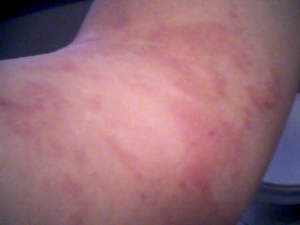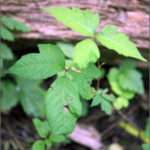One of the perils of working in gardens in the summers is the omni-present poison ivy. Some people are fortunate enough to be completely immune to it. Others of us are not so fortunate. And no matter how careful I seem to be, two years in a row now, I have gotten a nasty case of it.
First thoughts must be that I have no idea what poison ivy even looks like. Fear not, I researched it quite well last summer before I started working in messy yards, and thought I knew quite well what it looked like.
In my first round with poison ivy, I didn’t even know I had touched it. I was cleaning out “sticky weed” from the back part of a bush. Apparently a tiny poison ivy vine was mixed in with the “sticky weed” and I pulled it right out of the bush. It was hot outside, so I was rubbing my sweaty inner elbows. I had gotten several bug bites when working with my friend in her yard. I tend to scratch in my sleep, and had opened up a mosquito bite in my leg. The urushiol then made its way into the bug bite, resulting in a nasty cellulitis infection.
Cellulitis is an inflammation under the skin, related to the staph or strep bacteria. The skin surrounding the entry area becomes bright red and hot to the touch. It is also quite itchy. Sometimes you even spike a fever. Blisters have a tendency to drain, and your skin will dry out and flake off. It requires a strong antibiotic, as well as topical ointments. Left untreated, it can damage your lymph nodes and enter the bloodstream.
My bout with cellulitis last year was a hot spot with a six-inch diameter right above my right knee. It spread to two other three-inch spots on my lower leg. My arms were covered with poison ivy rashes. I was miserably tired, itchy, and in pain. My doctor had me take cephalexin (generic for Keflex) for ten days. I also had to take Claritin during the day and Benadryl at night. To relieve the itch, I had to cover the areas with a cortisone cream or gel. Then to heal the infection from the outside, as well as the inside, I applied antibacterial ointment and covered the areas with gauze.
I also found after the first day of taking the antibiotic that I had developed a secondary rash, right around the collar of my t-shirt. I immediately went back in to the doctor. He determined that the antibiotic was making my skin extra sensitive, even to cotton, and I just needed to grin and bear it while applying cortisone.
I was sick enough to miss work for two days, and couldn’t work in gardens for a week. The healing process took a long time.
This year, I again encountered poison ivy, which is a risk you take when working in yards. It has been recommended that I wear long sleeves and pants, with covered shoes and gloves. I try to oblige, but it is difficult to wear long sleeves when it is 95 degrees outside. Alas, I paid the price.
When working in a yard with known poison ivy, I somehow also scratched my arm. I wasn’t aware of the scratch, as it looked more like a stubborn dirt mark. I washed my hands and arms as soon as I was finished with my five hour weeding ordeal. I did not pull any of the poison ivy, but I was close to it.
Sure enough, by the next day, I had a small poison ivy rash near the scratch. By the next day, there was a warm red spot starting to spread around the scratch. Knowing immediately that I had cellulitis, I went to the clinic that evening after work.
This time around, I was given a seven-day regimen of cephalexin, and a prednisone pack. That night, I had to take one antibiotic, six steroids, and Benadryl. I also kept the area covered with Corti-Cool, which is a great cortisone gel that cools the flaming itch on contact, and an antibiotic ointment, covered with a large bandage.
Side effects this time around include some swelling and bloating from the steroids. As I was weaned off the steroids for the poison ivy, I could feel the bloating dissipate. I developed the secondary rash, again, from the antibiotic. I also have some interesting other rashes on my arms. This time, I believe that I have also developed an irritation to Virginia Creeper. Doing research on that plant, I found that a small number of humans do have a sensitivity to that plant. The medications seem to be helping that as well.
This year I noticed that I have been more tired, but I am also taking Benadryl any time I do not have to go anywhere. Lots of sleep, frequent cleansing of the rashes, and application of the over-the-counter ointments have been helping me cope.
Poison ivy is a nasty rash. Recommended treatments include cortisone or calamine lotions. Taking an over-the-counter allergy medication can also help. Not everyone experiences the same type of reaction. Going to the doctor can also help, as frequently he can prescribe steroids.
If you find yourself in poison ivy, quickly wash off the exposed skin with cool water. Hot water can open the pores, thus allowing the urushiol penetrate more.
Try rinsing the area with rubbing alcohol. Immediately wash all tools with rubbing alcohol. Wash all clothing, footwear, and gloves in hot water. The oils can stay on these items for a long time, thus infecting you time and time again, even months after the initial exposure.
Relieve the itch by using calamine lotion or cortisone. Take a bath in oatmeal, baking soda, or vinegar.
Watch for the signs of infection. As soon as you notice the rash spreading, or especially if you have a warm red spot surrounding the rash, immediately seek medical attention.
Source:
“Cellulitis”. MayoClinic.com http://www.mayoclinic.com/health/cellulitis/DS00450
Poison Ivy Website http://poison-ivy.org


